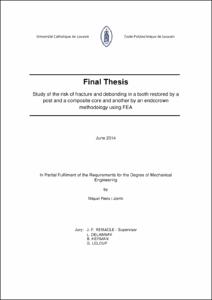Mostra el registre d'ítem simple
Study of the risk of fracture and debonding in a tooth restored by a post and a composite core and another by an endocrown methodology using FEA
| dc.contributor | Remacle, Jean-François |
| dc.contributor.author | Riera i Jorrín, Miquel |
| dc.date.accessioned | 2015-01-11T15:29:30Z |
| dc.date.available | 2015-01-11T15:29:30Z |
| dc.date.issued | 2013 |
| dc.identifier.uri | http://hdl.handle.net/2099.1/24469 |
| dc.description.abstract | This Thesis is the result of collaboration with the dental research center CRIBIO. Therefore it links two different worlds, the worlds of dentistry and engineering. That link allows the dentists to improve their research through new methods and tools, which are unknown for them. Focusing more specifically on the dental problems to be addressed: the esthetic and functional rehabilitation of endodontically treated teeth has been the subject of several studies that have sought to understand the different physical, chemical, and biomechanical properties of teeth. Thus, identifying the most suitable restorative approach to reestablishing the mechanical properties of the sound tooth is important. Different materials and post systems have been proposed for the rehabilitation of endodontically treated teeth. Cast posts and cores have a higher elastic modulus than dentin and have been used for several decades. In response to the need for esthetic materials with mechanical properties similar to those of root dentin, nonmetal posts were developed [1,2,3]. In vitro and in vivo studies have found that glass-fiber post and a resin core are an excellent alternative to metal [1,2,3] and other nonmetallic posts because of their elastic modulus, which is closer to that of dentin and which decreases the risk of root fracture, although the latest studies have shown a new trend, which is based on repairing the teeth without placing a post (Endocrown methodology), but with a crown resin composite and gutta-percha filling the root canal. This last technique, unlike the post based restoration, avoids drilling the root canal thus reducing the risk of root damages during the restoration [3-6]. |
| dc.language.iso | eng |
| dc.publisher | Universitat Politècnica de Catalunya |
| dc.publisher | Université catholique de Louvain |
| dc.rights | Attribution-NonCommercial-NoDerivs 3.0 Spain |
| dc.rights.uri | http://creativecommons.org/licenses/by-nc-nd/3.0/es/ |
| dc.subject | Àrees temàtiques de la UPC::Enginyeria dels materials::Disseny i selecció de materials |
| dc.subject.lcsh | Dental implants |
| dc.subject.lcsh | Dental materials |
| dc.title | Study of the risk of fracture and debonding in a tooth restored by a post and a composite core and another by an endocrown methodology using FEA |
| dc.type | Bachelor thesis |
| dc.subject.lemac | Implants dentals |
| dc.subject.lemac | Materials dentals |
| dc.rights.access | Open Access |
| dc.audience.educationlevel | Grau |
| dc.audience.mediator | Escola Tècnica Superior d'Enginyeria Industrial de Barcelona |
| dc.description.mobility | Outgoing |


